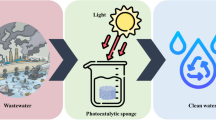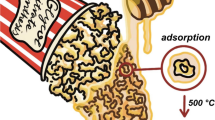Abstract
A facile one-pot microwave assisted solvothermal synthesis using various ratios of ethylene glycol (EG) and ethanol was developed to synthesize flower-like BiOBr microspheres. Such synthesized microspheres were characterized using X-ray photoelectron spectroscopy, X-ray diffraction, field emission scanning electron microscopy, high resolution transmission electron microscopy, the Brunauer–Emmett–Teller surface area, and UV–Visible diffuse reflectance spectra. Flower-like BiOBr microspheres were composed of loosely packed nanoplates which are interconnected to each other. Experimental results suggested that ethanol played a crucial role in directing the construction of microspheres without any misorientations. The photocatalytic activity of BiOBr microspheres was tested using the photodegradation of tartaric acid irradiated with visible light and compared with solvothermally synthesized BiOBr microspheres and commercial Bi2O3. BiOBr microspheres synthesized using the solvent mixture containing EG and ethanol at the ratio of 3:1 could degrade 98 % tartaric acid in 240 min with visible light (λ ≥ 400 nm) due to the synergistic effect of favorable microstructure with high surface area and suitable band gap of 2.92 eV. Since the resulting BiOBr microspheres are reusable without any loss in photocatalytic activity and more stable without any change in their morphology, it holds as a very promising photocatalysts for the treatment of organic pollutants.












Similar content being viewed by others
References
Anandan S, Kathiravan K, Murugesan V, Ikuma Y (2009) Anionic (IO3 −) non-metal doped TiO2 nanoparticles for the photocatalytic degradation of hazardous pollutant in water. Catal Commun 10:1014–1019
Yu C, Fan C, Meng X, Yang K, Cao F, Li X (2011) A novel Ag/BiOBr nanoplate catalyst with high photocatalytic activity in the decomposition of dyes. React Kinet Mech Catal 103:141–151
Khalil SS, Uvarov V, Fronton S, Popov I, Sasson Y (2012) A novel heterojunction BiOBr/bismuth oxyhydrate photocatalyst with highly enhanced visible light photocatalytic properties. J Phys Chem C 116:11004–11012
Kubacka A, García MF, Colon G (2012) Advanced nanoarchitectures for solar photocatalytic applications. Chem Rev 112:1555–1614
Yu YX, Ouyang WX, Zhang WD (2014) Photoelectrochemical property of the BiOBr–BiOI/ZnO heterostructures with tunable bandgap. J Solid State Electrochem. doi:10.1007/s10008-014-2402-6
Shen K, Gondal MA, Li Z, Li L, Xu Q, Yamani ZH (2013) 450 nm visible light-induced photosensitized degradation of Rhodamine B molecules over BiOBr in aqueous solution. React Kinet Mech Catal 109:247–258
He M, Sun K, Xia J, Li H, Xu L, Di J, Xu H, Shu H (2013) Reactable ionic liquid-assisted solvothermal synthesis of flower-like bismuth oxybromide microspheres with highly visible-light photocatalytic performances. Micro Nano Lett 8:450–454
Zhang L, Cao XF, Chen XT, Xue ZL (2011) BiOBr hierarchical microspheres: microwave-assisted solvothermal synthesis, strong adsorption and excellent photocatalytic properties. J Colloid Interface Sci 354:630–636
Naveenraj S, Anandan S, Velmathi S, Asiri AM, Ashokkumar M (2013) Tuning of chalcogenide nanoparticles fluorescence by Schiff bases. J Photochem Photobiol A 254:12–19
Li G, Qin F, Yang H, Lu Z, Sun H, Chen R (2012) Facile microwave synthesis of 3D flowerlike BiOBr nanostructures and their excellent CrVI removal capacity. Eur J Inorg Chem 15:2508–2513
Li T, Luo S, Yang L (2013) Microwave-assisted solvothermal synthesis of flower-like Ag/AgBr/BiOBr microspheres and their high efficient photocatalytic degradation for p-nitrophenol. J Solid State Chem 206:308–316
Feng Y, Li L, Li J, Wang J, Liu L (2011) Synthesis of mesoporous BiOBr 3D microspheres and their photodecomposition for toluene. J Hazard Mater 192:538–544
Song S, Gao W, Wang X, Li X, Liu D, Xing Y, Zhang H (2012) Microwave-assisted synthesis of BiOBr/graphene nanocomposites and their enhanced photocatalytic activity. Dalton Trans 41:10472–10476
Liu ZS, Wu BT, Xiang DH, Zhu YB (2012) Effect of solvents on morphology and photocatalytic activity of BiOBr synthesized by solvothermal method. Mater Res Bull 47:3753–3757
Huo Y, Zhang J, Miao M, Jin Y (2012) Solvothermal synthesis of flower-like BiOBr microspheres with highly visible-light photocatalytic performances. Appl Catal B 111–112:334–341
Wang X, Liu W, Tian J, Zhao Z, Hao P, Kang X, Sang Y, Liu H (2014) Cr(VI), Pb(II), Cd(II) adsorption properties of nanostructured BiOBr microspheres and their application in a continuous filtering removal device for heavy metal ions. J Mater Chem A 2:2599–2608
Lin H, Zhou C, Cao J (2014) Ethylene glycol-assisted synthesis, photoelectrochemical and photocatalytic properties of BiOI microflowers. Chin Sci Bull 59(27):3420–3426
Zhang D, Li J, Wang Q, Wu Q (2013) High 001 facets dominated BiOBr lamellas: facile hydrolysis preparation and selective visible-light photocatalytic activity. J Mater Chem A 1:8622–8629
Cheng H, Huang B, Wang Z, Qin X, Zhang X, Dai Y (2011) One-pot miniemulsion-mediated route to BiOBr hollow microspheres with highly efficient photocatalytic activity. Chem Eur J 17:8039–8043
Zhang J, Huang F, Lin Z (2010) Progress of nanocrystalline growth kinetics based on oriented attachment. Nanoscale 2:18–34
Wu S, Dong Q, Wang J, Jia Q, Sun Y, Shan S, Wang Y (2015) Microwave-solvothermal synthesis of nanostructured BiOBr with excellent visible-light photocatalytic properties. J Nanomater. doi:10.1155/2015/489029
Shang M, Wang W, Zhang L (2009) Preparation of BiOBr lamellar structure with high photocatalytic activity by CTAB as Br source and template. J Hazard Mater 167:803–809
Shi X, Chen X, Chen X, Zhou S, Lou S, Wang Y, Yuan L (2013) PVP assisted hydrothermal synthesis of BiOBr hierarchical nanostructures and high photocatalytic capacity. Chem Eng J 222:120–127
Jung OJ, Kim SH, Cheong KH (2001) Photocatalytic degradation of pentachlorophenol (PCP) using TiO2 thin films by CVD method. Environ Eng Res 6:199–210
Fu J, Tian Y, Chang B, Xi F, Dong X (2012) BiOBr–carbon nitride heterojunctions: synthesis, enhanced activity and photocatalytic mechanism. J Mater Chem 22:21159–21166
Acknowledgments
The authors wish to thank for the financial support by the Ministry of Science and Technology in Taiwan under the contract number of 101-2221-E-35-031-MY3. The support in providing the fabrication and measurement facilities from the Precision Instrument Support Center of Feng Chia University is also acknowledged.
Author information
Authors and Affiliations
Corresponding author
Rights and permissions
About this article
Cite this article
Yang, CK., Naveenraj, S., Lee, GJ. et al. Microwave-Assisted Synthesis of BiOBr Microspheres for Photocatalytic Degradation of Tartaric Acids in Aqueous Solution. Top Catal 58, 1100–1111 (2015). https://doi.org/10.1007/s11244-015-0478-6
Published:
Issue Date:
DOI: https://doi.org/10.1007/s11244-015-0478-6




